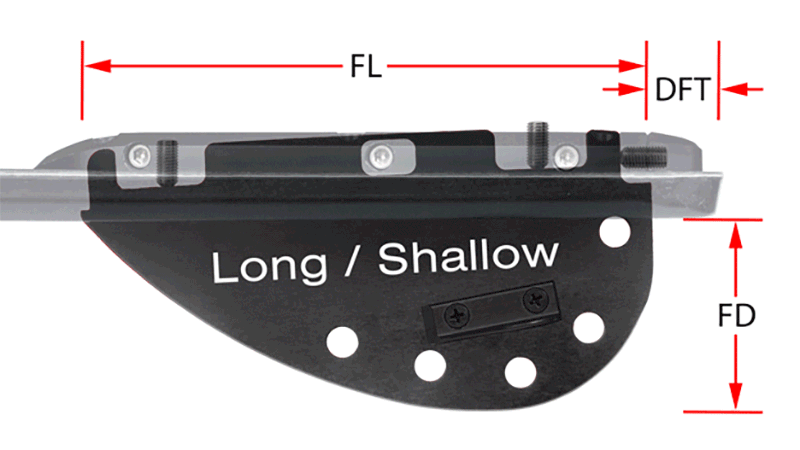Advanced, Fin, Setup, Ski Behavior
Long/Shallow vs. Short/Deep Fin Setup
If you’ve hung around many starting docks, you’ve probably heard hotshot slalom skiers talking about their preferences for long/shallow or short/deep fin setups. If you’ve found yourself wondering what they’re talking about, maybe this will help.
These terms refer to a relationship between fin length (FL) and fin depth (FD). Fin length can be set up to be long or short, fin depth can be set shallow or deep, and everything in between. However, there will always be an inverse relationship between FL and FD because of their effect on fin area (FA). As the fin gets longer, it has to get shallower or fin area will increase enough to add excessive traction to the tail of the ski, killing smear, and delivering huge sweeping school bus turns. If FA gets too small, the ski will tend to over-rotate at the ball, generating way too much angle and excessive loads.
In the past, many pros favored using setups that were shorter and deeper than the factory specs. But recently, many top skiers are riding long/shallow setups. This trend is partially due to ski design evolution, and the advent of Zero Off cruise control. But for many, this trend could just be the pendulum of change swinging away from past norms as good skiers look for an edge in trying something different. In fact, very few skiers have fully explored both extremes to develop a full appreciation of the actual differences between them.
I like to explore these extremes with every ski I keep for awhile. And what I find most remarkable is just how similarly these two radically different fin setups perform when properly dialed in. Both long/shallow and short/deep setups can deliver turns with the exact same radius and as much angle as any skier can handle—assuming the fin’s distance from tail (DFT) is used to fine-tune how much the tail smears. The biggest difference is how much the ski resists rolling up onto its edges.
The fin works like the keel on a sailboat, making it harder to roll the ski up onto an edge. This makes the ski feel really solid and secure. It will also require more strength to ski an early path through the course. But at the ball, tip-engagement will be as consistent and forgiving as it can be. With the ski riding a little flatter in roll, there’s less exposure to tip-grab and even the skier’s posture isn’t quite as critical—a good thing since most falls happen at the ball.
On the other hand, a long/shallow fin will let the ski roll more easily, and roll up onto a steeper edge. This may feel less secure at first, but when the whole ski is up on a steep edge, it converts the boat’s pull into cross-course speed more efficiently making it easier to run early in the course. Unfortunately, when the skier engages more tip for the turn at the ball, there is less resistance to this knife-edged tip-engagement, so it’s trickier to get consistent predictable turns around each ball.
Both fin extremes can work perfectly well, but as usual, there’s a trade-off. The skier has to choose between an easier, earlier path through the course (long/shallow setup), or stable predictable turns (short/deep setup). If you are really powerful behind the boat, then you might be able to take advantage of a short/deep fin’s consistent, confidence-inspiring turns.
In the alternative, if the water-break is well forward on your ski’s tip before arriving at the ball, then inconsistent tip-engagement probably isn’t a problem for you, and a long/shallow fin can help you ski earlier with less effort. If you are neither powerful behind the boat nor well over the front of your ski before turning at the ball, then coaching will likely improve your performance more than anything you can do with your fin.
Most factory setups fall somewhere in between these two extremes. This too is a compromise. If you are a tournament skier looking to maximize your performance, you can probably improve your scores by customizing your setup to take advantage of your personal strengths. But why guess at which extreme works best for you? Ideally, you should experiment with both extremes. In Fin Whispering—Demystifying the Black Art of Water Ski Tuning, you’ll learn how to test these two fin setup extremes back-to-back in one ski outing, or any time you like.
SkiJay
![]()

